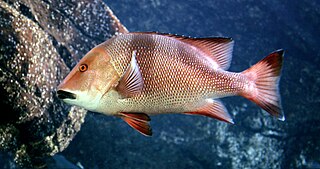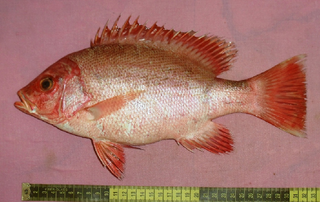
The bigeye snapper, also known as the bigeye seaperch, red sea lined snapper, golden striped snapper, rosy snapper, yellow snapper, or simply snapper, is a species of marine ray-finned fish, a snapper belonging to the family Lutjanidae. It is native to the Indian Ocean and the western Pacific Ocean. It is the type species of the genus Lutjanus.

Lutjanus sebae, also known as red emperor, emperor red snapper, emperor snapper, government bream, king snapper, queenfish or red kelp, is a species of marine ray-finned fish, a snapper belonging to the family Lutjanidae. It is native to the Indian Ocean and the western Pacific Ocean.

Lutjanus quinquelineatus, the five-lined snapper, blue-striped snapper, blue-banded sea-perch, five-lined seaperch or gold-striped sea-perch, is a species of ray-finned fish, a snapper belonging to the family Lutjanidae. It is native to the Indian Ocean and the western Pacific Ocean.

Lutjanus adetii, the yellow-banded snapper or hussar, is a species of marine ray-finned fish, a snapper belonging to the family Lutjanidae. It is native to the southwestern Pacific Ocean. This species is of minor importance to local commercial fisheries and is sought after as a game fish.

The dog snapper, also known as the dogtooth snapper, pargue or snuggletooth snapper, is a species of marine ray-finned fish, a snapper belonging to the family Lutjanidae. It is native to the Atlantic Ocean. It is a commercially important species, and is popular for display in public aquaria.

The humpback red snapper, the paddletail, paddletail snapper or hunchback snapper, is a species of marine ray-finned fish, a snapper belonging to the family Lutjanidae. It has a wide Indo-West Pacific distribution. It is a commercially important species, as well as being sought after as a game fish. It is also a popular species for display in public aquaria. It has been reported to cause ciguatera poisoning.

Lutjanus russellii, Russell's snapper, Moses snapper, fingermark bream, Moses seaperch or Russell's sea-perch, is a species of marine ray-finned fish, a snapper belonging to the family Lutjanidae. It is native to the western Pacific Ocean.

Lutjanus fulvus, the blacktail snapper, flametail snapper, redmargined seaperch, Waigeu snapper or yellowmargined sea perch, is a species of marine ray-finned fish, a snapper belonging to the family Lutjanidae. It is native to the Indo-West Pacific region. It is an important species for fisheries within its range.

Lutjanus erythropterus, the crimson snapper, crimson seaperch, high-brow sea-perch, Longman's sea perch, red bream, saddle-tailed perch, small-mouth nannygai or smallmouth sea perch is a species of marine ray-finned fish, a snapper belonging to the family Lutjanidae. It is found in the Pacific and Indian Oceans.

Lutjanus vitta, the brownstripe red snapper, brownstripe snapper, broadband seaperch, brownstripe seaperch, one-band sea-perch, one-lined snapper or striped seaperch, is a species of marine ray-finned fish, a snapper belonging to the family Lutjanidae. It is native to the western Pacific and Indian Oceans.

Lutjanus malabaricus, the Malabar blood snapper, saddletail snapper, large-mouthed nannygai, large-mouthed sea-perch, Malabar snapper, nannygai, red bass, red bream, red emperor, red Jew, red snapper, saddletail seaperch, scarlet emperor or scarlet sea-perch, is a species of marine ray-finned fish, a snapper belonging to the family Lutjanidae. It is native to the Indian Ocean and the western Pacific, where it is found east to Fiji and Japan.

Lutjanus lemniscatus, the yellowstreaked snapper, darktail snapper, darktail seaperch or maroon sea-perch is a species of marine ray-finned fish, a snapper belonging to the family Lutjanidae. It is native to the western Pacific and Indian Oceans.

Lutjanus johnii, John's snapper, the golden snapper,big-scaled bream, fingermark bream, fingerbanger, fingermark seaperch, John's sea-perch, or spotted-scale sea perch, is a species of marine ray-finned fish, a snapper belonging to the family Lutjanidae. It is native to the western Pacific and Indian Oceans.

Lutjanus decussatus, the checkered snapper, checkered seaperch or cross-hatched snapper, is a species marine ray-finned fish belonging to the family Lutjanidae. It is native to the western Pacific and Indian Oceans.

Lutjanus carponotatus, the Spanish flag snapper, stripey snapper, dusky-striped sea-perch, gold-banded sea perch, gold-stripe sea-perch, striped seaperch or stripey seaperch, is a species marine ray-finned fish, a snapper belonging to the family Lutjanidae. It is native to the western Pacific and Indian Oceans, from India to northern Australia.

Lutjanus monostigma, the one-spot snapper, onespot seaperch or Moses snapper, is a species of marine ray-finned fish, a snapper belonging to the family Lutjanidae. It is found in the Indo-Pacific region.

Lutjanus purpureus, the southern red snapper or Caribbean red snapper, is a species of marine ray-finned fish, a snapper belonging to the family Lutjanidae. It is native to the western Atlantic Ocean as well the Caribbean Sea.

Lutjanus endecacanthus, the Guinea snapper, is a species of marine ray-finned fish, a snapper belonging to the family Lutjanidae. It is found on the west coast of Africa in the eastern Atlantic Ocean.

Lutjanus novemfasciatus, the Pacific dog snapper or Pacific cubera snapper, is a species of marine ray-finned fish, a snapper belonging to the family Lutjanidae. It is native to the eastern Pacific Ocean.

The silk snapper, the West Indian snapper, yellow-eyed snapper or yellow-eyed red snapper, is a species of marine ray-finned fish, a snapper belonging to the family Lutjanidae. It is found in the Western Atlantic Ocean.





















